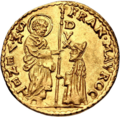Papal lira
| lira pontificia (Italian) | |
|---|---|
 20 lire | |
| Unit | |
| Nickname | franc |
| Denominations | |
| Subunit | |
| 1⁄20 | soldo (s.) |
| 1⁄100 | centesimo (c.) |
| Coins | c.1, s.1⁄2, s.1, s.2, s.4, s.5, s.10 L.1, L.2, L.2+1⁄2, L.5 |
| Rarely used | L.10, L.20, L.50, L.100 |
| Demographics | |
| Official user(s) | |
| Unofficial user(s) | |
| Issuance | |
| Mint | Papal Mint |
| Valuation | |
| Pegged with | French franc |
| This infobox shows the latest status before this currency was rendered obsolete. | |
The lira was the currency of the Papal States between 1866 and 1870. It was subdivided into 20 soldi, each of 5 centesimi.
History
In 1866 Pope Pius IX, whose temporal domain had been reduced to only the province of Latium, decided to join the Latin Monetary Union. A new currency, the lira, was introduced with the same value of the French franc and the Italian lira. It replaced the scudo at a rate of 5.375 lire = 1 scudo : the rate was calculated thanks to the silver value of the old scudo (26.9 grams of 0.900 fine silver[citation needed]) and the new lira (5 grams of 0.900 fine silver). However, some time[when?] after joining the Union, the Pope's treasurer, Giacomo Antonelli, devalued the purity of the Papal silver coins from 900/1000 to 835/1000,[1] causing big problems for the Union, which later was forced to adopt the new standard.[citation needed] With the annexation of the Papal States to Italy in 1870, the Papal lira was replaced by the Italian lira at par.
The lira was subdivided into 100 centesimi and, differently from the other currencies of the union, into 20 soldi. However, all denomination in soldo had an equivalence in cents.
Coins
Copper coins were issued in denominations of c.1, s.1⁄2, (c.2+1⁄2), s.1 (c.5), s.2 (c.10) and s.4 (c.20), with silver s.5 (c.25) and s.10 (c.50), 1, 2, 2+1⁄2 and 5 lire, and gold 5, 10, 20, 50 and 100 lire.
See also
References
- ^ Pinchera, S (a cura di) (1957). Monete e zecche nello stato pontificio dalla restaurazione al 1870 [Coins and mints in the papal state from the restoration to 1870]. Archivio economico dell’unificazione italiana. Vol. V, fasc. 3. Roma.
{{cite book}}: CS1 maint: location missing publisher (link) (cited in Rossi, Marinella (2013). La borsa di Roma dal 1847 al 1860 [The Rome Stock Exchange from 1847 to 1860] (PDF) (Thesis) (in Italian). Tesionline. p. 1. (first degree thesis))
- Krause, Chester L.; Clifford Mishler (1991). Standard Catalog of World Coins: 1801–1991 (18th ed.). Krause Publications. ISBN 0873411501.
External links

